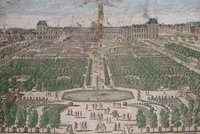Tuileries Palace
|
|
Up to 1871 the Tuileries Palace was a palace in Paris, France, on the right bank of the River Seine.
After the death of Henry II of France in 1559, his widow, Catherine de' Medici (1519-1589) planned a new palace. She began the building of the palace of Tuileries in 1564, using architect Philibert de l'Orme. The name derives from the tile kilns or tuileries which previously occupied the site. The palace was formed by a series of long, narrow buildings with high roofs that created one major and two minor courtyards. The southeast corner of Tuileries joined the Louvre. The building was greatly enlarged in the 1600s.
King Louis XIV resided at the Tuileries Palace while Versailles was under construction. His garden designer André Le Notre laid out parterres for the Tuileries in 1664, but when the King left, the building was virtually abandoned. It was used only as a theater. During the French Revolution, Louis XVI and his family were forced to live there under house arrest, starting in October 1789. They tried to escape on the evening of June 20, 1791, but were captured at Varennes and were returned to the Tuileries. The Tuileries were later stormed on August 10, 1792 by the Paris mob, who overwhelmed and massacred the Swiss Guards; the royal family fled through the gardens and took refuge with the Legislative Assembly.
Tuiler2.jpg
The Tuileries Palace was situated enclosing the two wings in the bottom part of the picture
For a time, the National Convention held its sessions in the Tuileries. When Napoleon came into power he made Tuileries the official residence of the first consul and then the imperial palace. In 1808 Napoleon began constructing the northern gallery which also connected to the Louvre.
As Napoleon's chief residence Tuileries Palace was redecorated in the Neoclassical Empire style by Percier and Fontaine and some of the best known architects, designers, and furniture makers of the day. One of the artists, Pierre Paul Prud'hon's (1758-1823) most splendid commissions was to design the apartments of the new Empress, Marie-Louise, in the Tuileries Palace. For the bridal suite of the Empress Marie-Louise he designed all the furniture and interior decorations in a Greek Revival style.
In 1809, Jacob-Desmalter, principal supplier of furniture to the Emperor, began work on a jewel cabinet designed for the Empress Joséphine's great bedroom in the Tuileries (and soon to be used by Marie-Louise). This impressive piece of furniture which was designed by the architect Charles Percier was embellished with several bronze ornaments: the central panel depicts the "Birth of the Queen of the Earth to whom Cupids and Goddesses hasten with their Offerings" by Pierre-Philippe Thomire, after a sculpture by Chaudet. Jacob-Desmalter completed the "great jewelry box" in 1812, with two smaller items of furniture in the same style but using indigenous woods.
Edouard_Manet_036.jpg
The Tuileries Palace served as the royal residence after the Bourbon Restoration. In the "July Revolution, July 29, 1830, the palace was attacked for a third time by Parisians and occupied. Louis Philippe took up permanent residence there until 1848 when it was again invaded, on February 24, 1848. The Swiss Guards stationed at the palace, aware of what happened in 1792 to their predecessors, abandoned the palace. The Tuileries was never again used as a royal residence.
Supporters of the Paris Commune destroyed most of the palace in 1871. Its burnt-out shell stood for twelve years before it was demolished and the present gardens, formerly west of the palace, extended. For the first time the Louvre courtyard opened into an unbroken Axe historique. The Tuileries Gardens (French Jardins des Tuileries) are surrounded by the Louvre (to the east), the Seine (to the south), the Place de la Concorde (to the west) and the Rue de Rivoli (to the north). Farther to the north lies the Place Vendôme.
Ivue.jpg
The gardens cover about 63 acres (25 hectares) and still closely follow a design laid out by landscape architect Andre Le Notre in 1664. His spacious formal garden plan drew out the perspective from the reflecting pools one to the other in an unbroken vista.
The Galerie nationale du Jeu de Paume is a museum of contemporary art located in the north-west corner of the gardens.
External link
- Jardin des Tuileries (http://www.insecula.com/musee/M0039.html/)
de:Tuilerien fr:Tuileries ja:テュイルリー宮殿 nl:Tuilerieën fi:Tuileries

